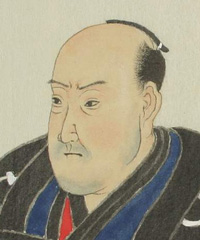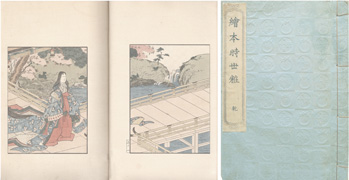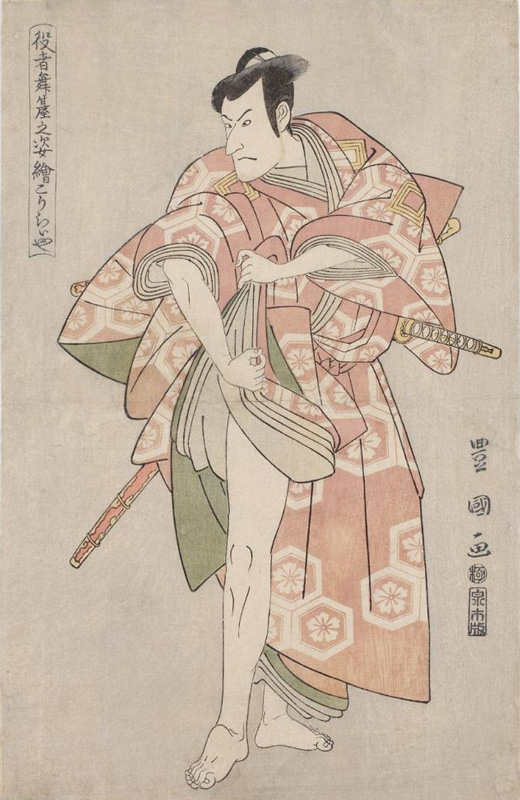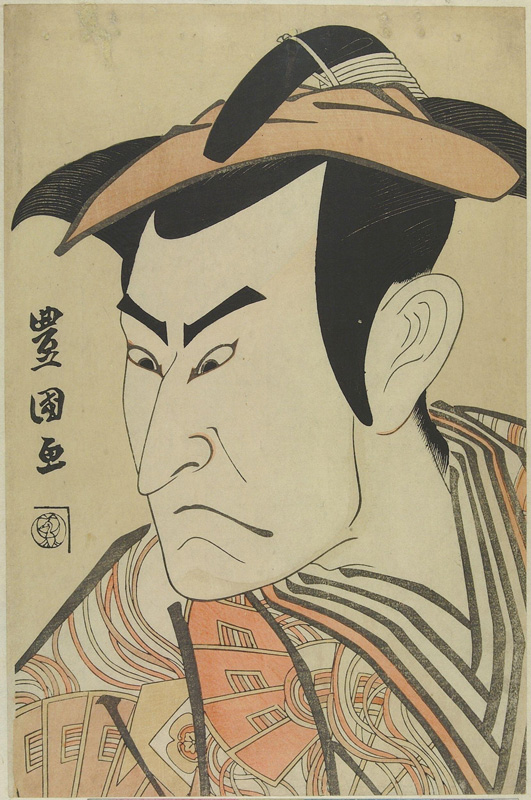Biographical Data
Profile
Utagawa Toyokuni 歌川豐国 (1769-1825)Source: Masters of the Japanese Print, Richard Lane, Thames and Hudson, 1962, p. 240, 246, 248; The Japanese Print: A Historical Guide, Hugo Munsterberg, Weatherhill, 1982, p. 105; The Hotei Encyclopedia of Japanese Woodblock Prints, Amy Reigle Newland, Hotei Publishing Company, 2005, p.502-503; The Japanese Print: A Historical Guide, Hugo Munsterberg, Weatherhill, 1982, p.128-131; The Art of Japanese Prints, Richard Illing, John Calmann & Cooper Ltd., 1980, p. 56-57.
Toyokuni entered the studio of his neighbor Utagawa Toyoharu (1735-1814) at an early age, being allowed to assume the Utagawa name in 1784. Issuing his first book illustrations in his mid-teens, he would go on to design prints of beautiful women (bijin-ga) and become most famous for his portrayal of Kabuki actors (yakusha-e and nigao-e), a genre which he would dominate for almost thirty hears. While he is described, somewhat derogatorily, as "the great eclectic of ukiyo-e...reaching out over the whole range of his contemporaries for styles to emulate" he synthesized what he learned to create his own style, becoming "for a time the leading figure in the world of ukiyo-e art."
Biography
 cropped from a portrait of the artist by his student Utagawa Kunisada (Toyokuni III), from Gisaku Rokkasen (1856) | Sources: Japanese Woodblock Prints: Artists, Publishers and Masterworks 1680–1900, Andreas Marks,Tuttle, 2010, p. 96; Wikipedia https://en.wikipedia.org/wiki/Utagawa_Toyokuni and as footnoted; Names: Utagawa Toyokuni 歌川豐国 (Toyokuni also seen as 豐圀, 豊國) Family name (姓 - sei): Kurahashi (倉橋) Childhood name (幼名 - yōmyō): Kumakichi (熊吉) Nickname (通称 - tsūshō): Kumaemon (熊右衛門) Artist names (号 - gō): Utagawa Toyokuni (歌川豊国), Utagawa Ichiyōsai (歌川 一陽斎), Ichiyōsai Toyokuni (一陽斎 豊国) Toyokuni was born in Shinmeimae Mishimachō in Edo's Shiba district, the son of Kurahashi Gorobei, a carver of dolls and puppets, including replicas of kabuki actors. At around 14, he was apprenticed to the founder of the Utagawa school, Utagawa Toyoharu 歌川 豊春 (1735-1814), whom his father knew well and who lived nearby. His first known work, book illustrations, dates to 1786 and his earliest print dates to the ninth month 1789. |
Toyokuni rose to prominence in ukiyo-e circles with the success of his series of prints Portraits of Actors on Stage (Yakusha butai no sugata-e), issued from 1794 to 1796. His elegantly flowing line and cheerful color schemes produced a lively and vivid sense of realism which established the direction for subsequent developments in actor portraiture.1
Close friends with some of the important actors of his time he gained access to their offstage lives adding to the power of his portraits. "His actor prints for the 1790s and 1800s are remarkable for their bold, taut designs and sharply characterized faces."2
A prolific artist he designed over ninety print series, many hundreds of single sheet prints, and illustrations for over 400 books. "Like so many other print designers, however, his later works suffered from over-production and as a result declined in quality."3
Active until his death, Toyokuni died at the age of 57 on the seventh day of the first month 1825.
Students
Among the best known of Toyokuni's innumerable pupils were his son-in-law Toyoshige (1777–1835), who after his master's death took the name Toyokuni II; Kuniyoshi (1798-1861); Kunimasa (1773-1810) and Utagawa Kunisada I (1786–1865), who called himself Toyokuni III.4
1 British Museum website biography https://www.britishmuseum.org/collection/term/BIOG6936.
2 The Hotei Encyclopedia of Japanese Prints, Vol.2, ed. Amy Reigle Newland, Hotei Publishing, 2005 p. 502.
3 Ukiyo-e: The Art of Japanese Woodblock Prints, ed. Amy Newland, Chris Uhlenbeck, Knickerbocker Press, 1999, p. 61.
4 The Japanese Print: A Historical Guide, Hugo Munsterberg, Weatherhill, 1982, p.109
latest revision:
7/18/2021 created


